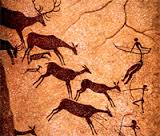The history books mention that our ancestors could live on it.
If not, we would not be here now.
 Throughout the centuries, and millennia, the techniques, methods and materials for hunting and fishing in our means of (sustainable) livelihood have improved tremendously.
Throughout the centuries, and millennia, the techniques, methods and materials for hunting and fishing in our means of (sustainable) livelihood have improved tremendously.
The Optimal Foraging Theory (OFT) is a model that helps predict how an animal (human) behaves when looking for food. It will always use that strategy that offers the most benefits (energy) for the least cost (time and effort). Eating insects and even cannibalism often seem like a good choice.
Fishing anglers even use computers and sonar. And fiber-reinforced carbon rods. Or vice versa. Once within reach, sharks or whales have no longer a real chance to escape the harpoon or net.
With a bullet we can land a rhino. Cages, clamps, hail and night vision make hunting an unfair and for the animal in advance loosed battle. We have more guns than game. But once it went to the struggle for life. With an often uncertain outcome.
With simple and primitive means.
Traps and snares have the advantage that you have to spend less energy (and time) to capture prey. Some of them are anything but friendly. But if it's a matter of survival...
Animal biomass is distributed. Small mammals like hedgehogs, squirrels, martens, etc. would count for about 5 kilos /ha, larger animals like deer and boar contains 3 kg /ha but are more difficult to find (and especially in rivers and lakes). The larger the animal body, the greater the prestige of the hunter. Still. (Just look at pictures posted: carp, shark, hog...) And in addition, there’s snails, reptiles, insects, birds... (Underground you will find much more biomass and 'meat' than above ground.)
What do you call a boomerang that does not come back?? A stick.
"You know, there are hunting dogs that are smarter than their boss!”“Yeah, I got one.”(JW Besouw)
